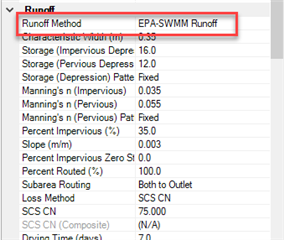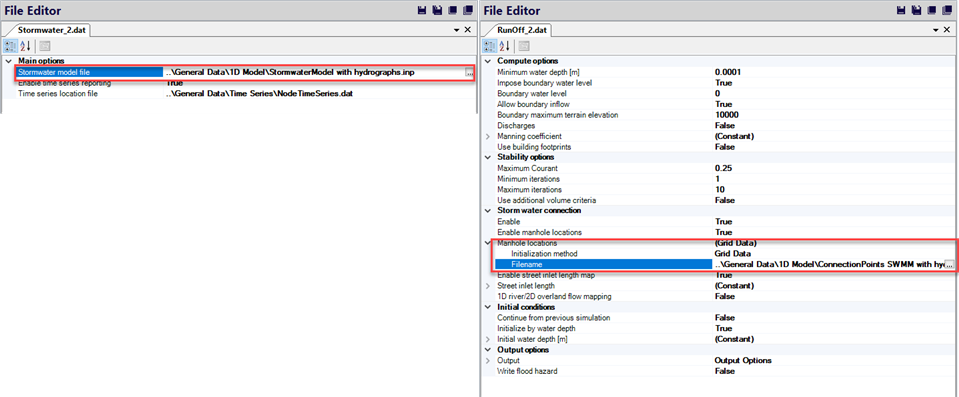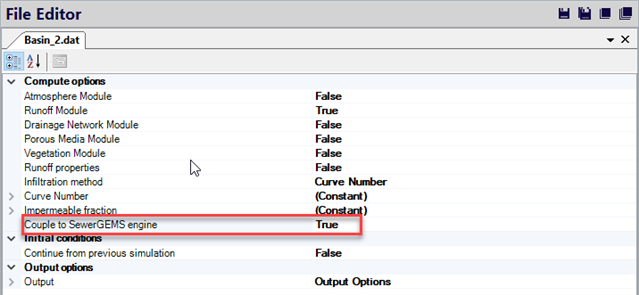| |
Product(s): |
OpenFlows FLOOD; CivilStorm and SewerGEMS |
|
| |
Version(s): |
10.03.00.01 (FLOOD) - 10.xx.xx.xx (CivilStorm /SewerGEMS) |
|
| |
Area: |
Modeling |
|
Background
When it´s necessary couple a 1D model from CivilStorm or SewerGEMS to OpenFlows FLOOD, user can choose different alternatives on how to incorporate rainfall water into the system.
OpenFlows FLOOD allows the user to opt by imposing direct rainfall on the 2D grid (you can check for instance this post) so that the rainfall water would enter the drainage network through the inlets., or, as an alternative, to use inflow hydrographs from catchments modeled in CivilStorm/SewerGEMS.

In the Urban Flooding Workshop is presented a situation where the inflows are taken by the FLOOD’s 2D runoff calculation and the loads enter in the network thru the inlets. The CivilStorm/SewerGEMS model used in this workshop doesn´t have any inflows placed in nodes or Catchment polygons.
If your 1D model has Catchment modeled, the polygons will be ignored by the FLOOD’s CivilStorm/SewerGEMS model coupling tool. Only inflows directly assigned to the nodes will be transported to FLOOD.

If it´s needed to calculate the inflow hydrographs from Catchment delineated in the CivilStorm/SewerGEMS, see the following article section.
Coupling a 1D Model with Inflow Hydrographs from Catchment Polygons
To make the Hydrology calculation from 1D model present in the flooding analysis it´s necessary to export CivilStorm/SewerGEMS scenario to SWMM V5 format – File > Export > SWMM V5.
It´s important that the 1D model to be coupled to FLOOD uses the Explicit Solver.
When exporting scenarios with Catchments to SWMM V5 format, Catchments that use the “EPA SWMM Runoff” method of calculation, will maintain their polygon shapes in the 1D model.

Catchments using other methods such as “Unit Hydrograph”, “Modified Rational”, “ILSAX”, etc, will be automatically converted into Hydrographs assigned to the outflow nodes.

After Exporting your model to SWMM, you will have the INP file to be coupled to your 2D model on OpenFlows FLOOD.
Use the “Connect SWMM model to MOHID land model” tool available under the Urban Floods toolbox:

In this tool, pick your projects DTM and browse the INP file exported from CivilStorm/SewerGEMS.
If your 1D model uses the “EPA SWMM Runoff” calculation method, Enable the option to “Keep SWMM Hydrology”:

For other Hydrology methods, you can leave this option Disabled.
This tool will create two files to be connected to the Stormwater and Runoff modules, similar the CiviStorm/SewerGEMS model coupling tool.

After clicking in Process, edit the Stormwater and Runoff modules to connect both files to your project:

Having a project that doesn't apply Rainfall curves, you can Disable the Atmosphere module in the Basin’s module:

Don’t forget to enable the Couple to SewerGEMS engine option also in the Basin’s module:

The rest of the Project configuration (e.g. DTM creation; 2D Runoff set up for the 2D calculation; Time Series reporting, etc.) is detailed in the Urban Flooding Workshop.
See Also
Learning Resources for OpenFlows FLOOD users
Integrating CivilStorm and SewerGEMS models to OpenFlows FLOOD